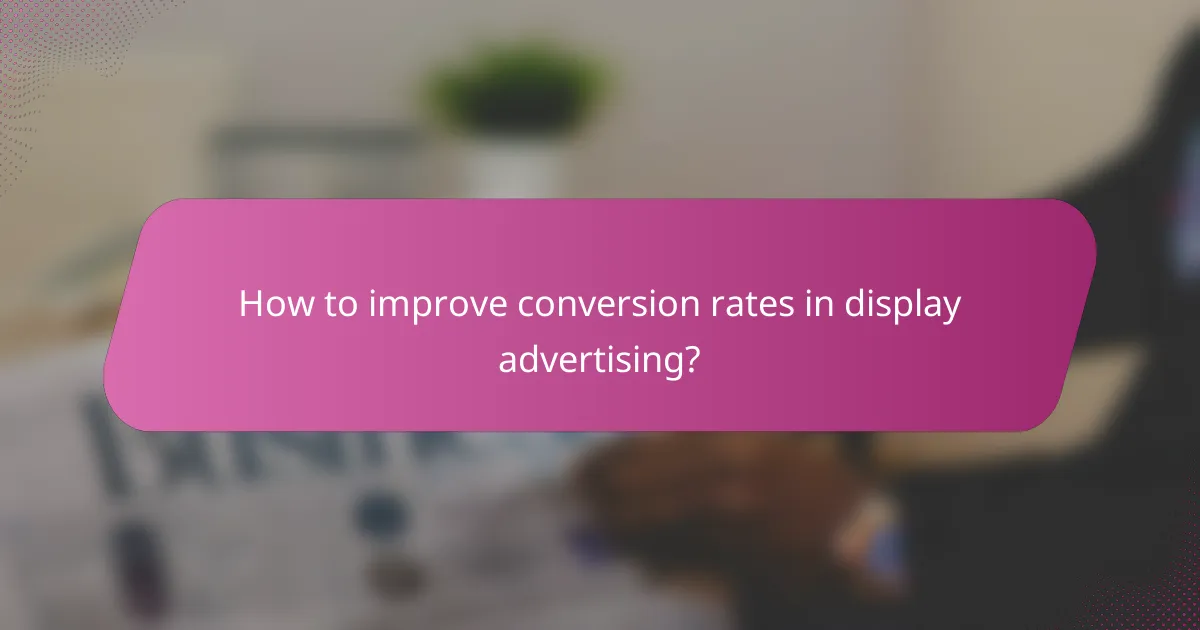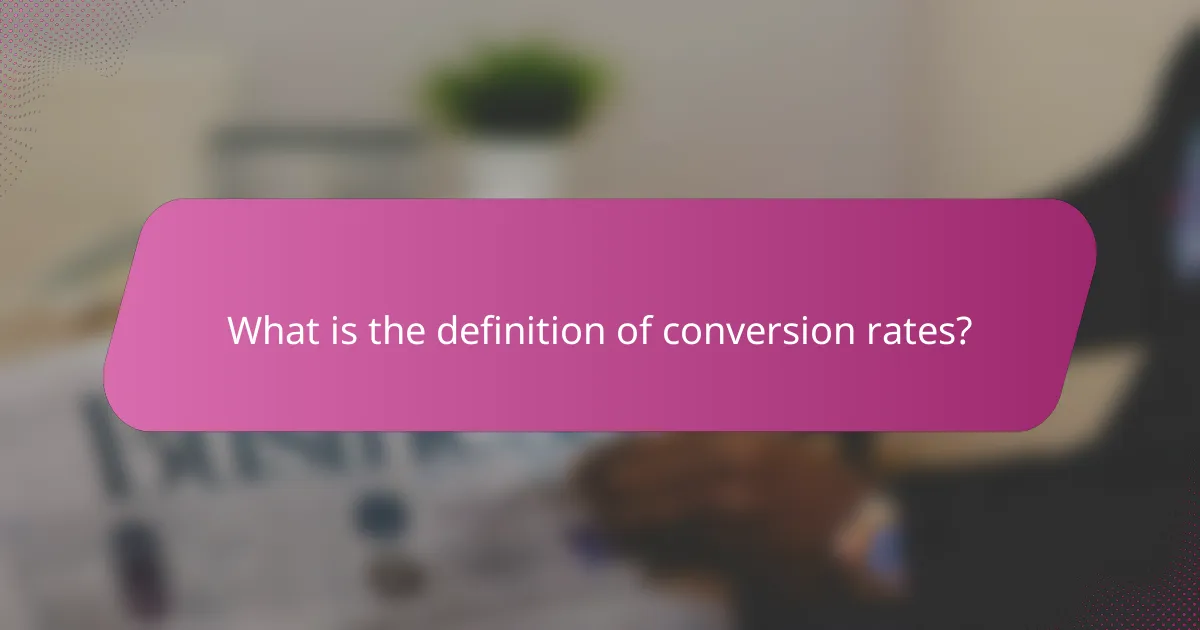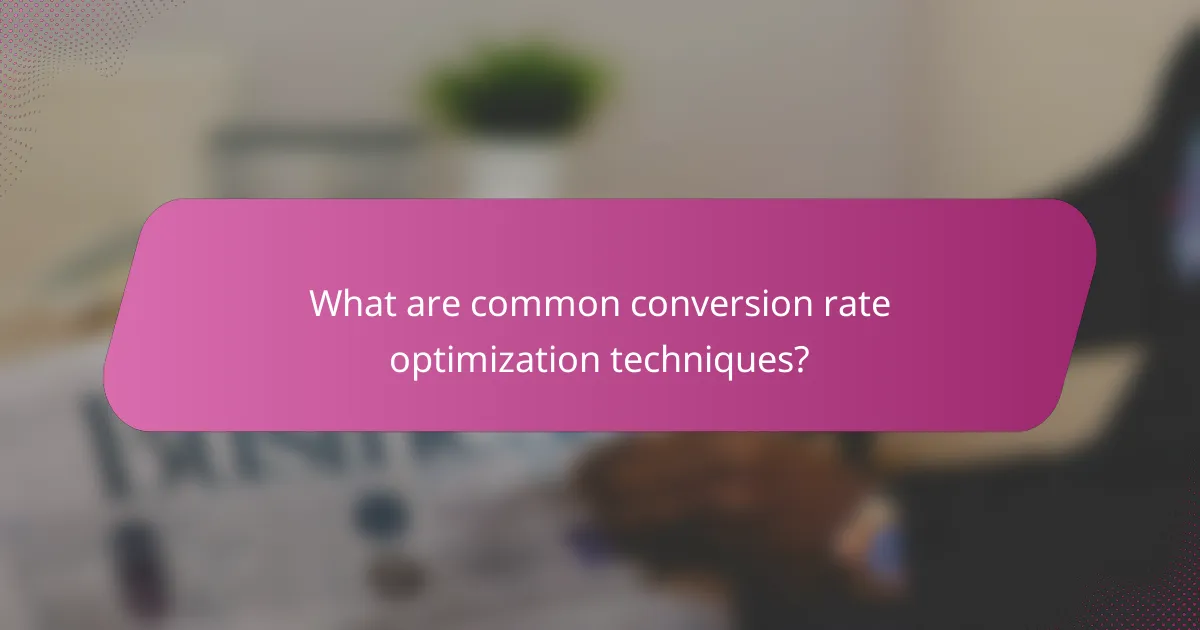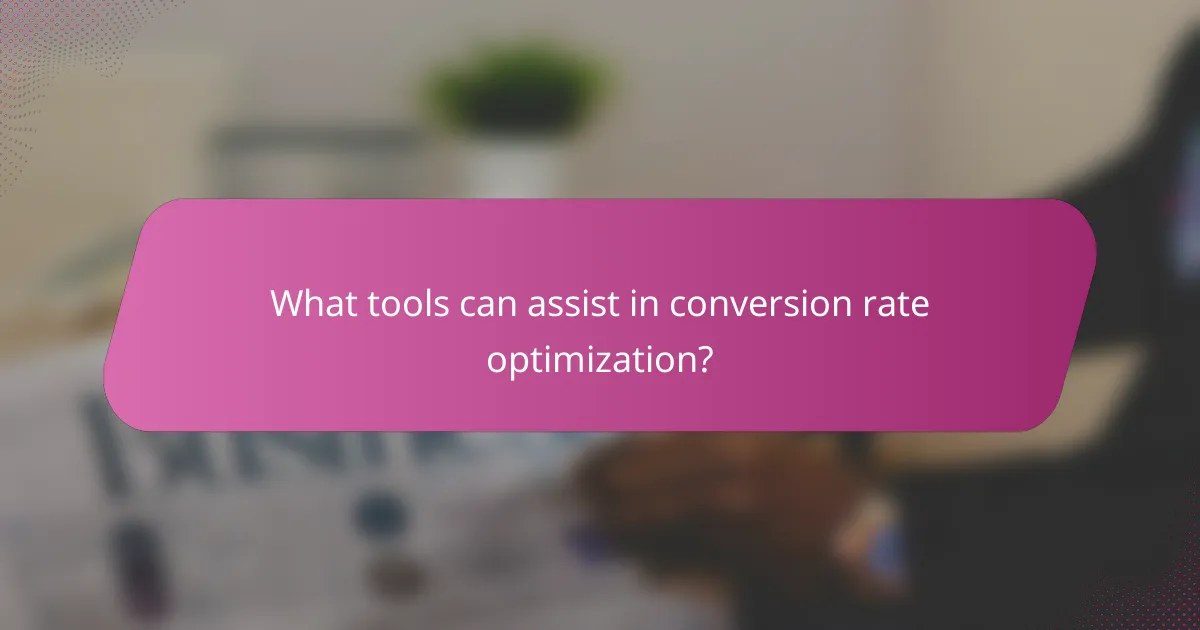Conversion rates are a vital metric that measures the percentage of website visitors who complete a desired action, such as making a purchase or signing up for a newsletter. Understanding the factors that influence these rates is essential for businesses aiming to optimize their online strategies and enhance user engagement. By focusing on elements like targeting, creative content, and retargeting, companies can effectively improve their conversion rates and drive better results.

How to improve conversion rates in display advertising?
Improving conversion rates in display advertising involves strategic adjustments to your campaigns that enhance user engagement and drive actions. Focus on testing, placement, targeting, creative elements, and retargeting to achieve better results.
Utilize A/B testing strategies
A/B testing allows advertisers to compare two versions of an ad to determine which performs better. By changing one element at a time, such as the call-to-action or image, you can gather data on user preferences and optimize accordingly.
Start with small changes and run tests for a sufficient duration to gather meaningful data. Aim for a sample size that provides statistical significance to ensure your findings are reliable.
Optimize ad placements
Ad placement significantly impacts visibility and engagement. Test various platforms and positions, such as above the fold or within content, to identify where your ads perform best.
Consider using analytics tools to track performance across different placements and adjust your strategy based on user interaction rates. Prioritize placements that yield higher click-through rates and conversions.
Enhance targeting options
Effective targeting ensures your ads reach the right audience, increasing the likelihood of conversions. Use demographic, geographic, and behavioral data to refine your targeting strategies.
Experiment with different audience segments and consider using lookalike audiences to reach potential customers similar to your existing ones. Regularly review and adjust your targeting criteria based on campaign performance.
Leverage compelling ad creatives
High-quality, engaging ad creatives capture attention and drive conversions. Focus on clear messaging, strong visuals, and a compelling call-to-action to encourage users to take the desired action.
Test different creative formats, such as video or interactive ads, to see what resonates best with your audience. Keep your branding consistent across all creatives to build recognition and trust.
Implement retargeting campaigns
Retargeting campaigns help re-engage users who have previously interacted with your ads or website. By reminding them of your offerings, you increase the chances of conversion.
Set up retargeting ads that display personalized content based on user behavior, such as items viewed or abandoned carts. Monitor the performance of these campaigns and adjust your messaging to improve effectiveness.

What factors influence conversion rates?
Conversion rates are influenced by several key factors that determine how effectively a website or landing page turns visitors into customers. Understanding these elements can help businesses optimize their strategies to improve performance and increase sales.
Ad relevance and quality
Ad relevance and quality significantly impact conversion rates by ensuring that the right audience sees the right message. High-quality ads that align with user intent tend to attract more clicks and drive better engagement. For example, using targeted keywords and compelling visuals can enhance ad performance.
To improve ad relevance, regularly analyze performance metrics and adjust your targeting strategies. Avoid generic messaging; instead, tailor your ads to specific audience segments for better results.
Landing page experience
The landing page experience is crucial for converting visitors into customers. A well-designed landing page should load quickly, be mobile-friendly, and provide clear information that matches the ad’s promise. Elements such as intuitive navigation and visually appealing layouts can enhance user experience.
To optimize landing pages, conduct A/B testing on different designs and content. Focus on reducing bounce rates by ensuring that the page meets visitor expectations and encourages them to take action.
Audience targeting accuracy
Accurate audience targeting is essential for maximizing conversion rates. By identifying and reaching the right demographic, businesses can ensure that their marketing efforts resonate with potential customers. Utilizing tools like customer personas and analytics can help refine targeting strategies.
Regularly review and update your audience profiles based on engagement data. This will help you stay aligned with shifting consumer behaviors and preferences, ultimately improving conversion outcomes.
Call-to-action effectiveness
The effectiveness of calls-to-action (CTAs) directly influences conversion rates. A strong CTA should be clear, compelling, and create a sense of urgency. Phrases like “Get Started Now” or “Limited Time Offer” can motivate users to act quickly.
To enhance CTA effectiveness, experiment with different placements, colors, and wording. Monitor conversion rates to identify which CTAs perform best, and continuously optimize them based on user feedback and behavior.

What is the definition of conversion rates?
Conversion rates refer to the percentage of visitors to a website who complete a desired action, such as making a purchase or signing up for a newsletter. This metric is crucial for evaluating the effectiveness of online marketing efforts and understanding user engagement.
Percentage of visitors completing a desired action
The conversion rate is calculated by dividing the number of conversions by the total number of visitors, then multiplying by 100 to get a percentage. For instance, if a website receives 1,000 visitors and 50 of them make a purchase, the conversion rate would be 5%. This metric helps businesses gauge how well their site encourages users to take specific actions.
Understanding the factors that influence conversion rates, such as website design, user experience, and product offerings, is essential. A well-optimized site can significantly improve conversion rates, often increasing them from low single digits to double digits.
Measurement of campaign effectiveness
Conversion rates serve as a key performance indicator (KPI) for assessing the success of marketing campaigns. By analyzing conversion rates, businesses can determine which strategies are working and which need adjustment. For example, a high conversion rate from an email campaign may indicate effective messaging and targeting.
To measure campaign effectiveness accurately, it is important to track conversion rates over time and across different channels. This allows for comparisons between various marketing efforts, helping to allocate resources more efficiently. Regularly reviewing these metrics can reveal trends and insights that inform future campaigns.

How to analyze conversion rate data?
Analyzing conversion rate data involves examining metrics to understand how effectively your website turns visitors into customers. Key methods include using analytics tools, tracking user interactions, and segmenting data to identify patterns and areas for improvement.
Use Google Analytics for insights
Google Analytics is a powerful tool for analyzing conversion rates. It provides detailed reports on user behavior, traffic sources, and conversion funnels, allowing you to pinpoint where visitors drop off in the purchasing process.
To get started, set up goals in Google Analytics that reflect your desired conversions, such as form submissions or product purchases. Monitor the conversion rates over time to identify trends and make data-driven decisions to enhance performance.
Track user behavior with heatmaps
Heatmaps visually represent user interactions on your website, showing where visitors click, scroll, and spend time. This data helps you understand which elements attract attention and which may need redesigning to improve conversion rates.
Tools like Hotjar or Crazy Egg can generate heatmaps. Regularly review these insights to optimize page layouts, call-to-action placements, and content positioning, ensuring they align with user interests and behaviors.
Segment data by audience demographics
Segmenting conversion rate data by audience demographics allows you to tailor marketing strategies to specific groups. Factors such as age, gender, location, and device type can significantly influence conversion behaviors.
Use Google Analytics or similar tools to create segments based on these demographics. Analyze how different groups interact with your site and adjust your messaging or offers accordingly to maximize conversions across diverse audiences.

What are common conversion rate optimization techniques?
Common conversion rate optimization techniques focus on enhancing user experience and increasing the likelihood that visitors will complete desired actions, such as making a purchase or signing up for a newsletter. Effective strategies include improving website performance, crafting compelling content, and leveraging social validation.
Improve website loading speed
Website loading speed is crucial for conversion rates; faster sites tend to retain visitors better. Aim for loading times under three seconds, as delays can lead to high bounce rates and lost opportunities.
To enhance loading speed, consider optimizing images, minimizing HTTP requests, and leveraging browser caching. Tools like Google PageSpeed Insights can help identify specific areas for improvement.
Use persuasive copywriting
Persuasive copywriting directly influences conversion rates by engaging visitors and encouraging them to take action. Focus on clear, concise language that highlights benefits and addresses potential objections.
Incorporate strong calls to action (CTAs) that create urgency, such as “Limited Time Offer” or “Join Now for Exclusive Benefits.” Testing different headlines and CTAs can reveal what resonates best with your audience.
Incorporate social proof
Social proof, such as customer reviews and testimonials, can significantly boost conversion rates by building trust and credibility. Displaying positive feedback prominently on your site reassures potential customers about their purchasing decisions.
Consider using star ratings, user-generated content, or case studies to illustrate the effectiveness of your products or services. Highlighting well-known brands or influencers who endorse your offerings can further enhance credibility.

What tools can assist in conversion rate optimization?
Several tools can significantly aid in conversion rate optimization (CRO) by providing insights and facilitating testing. These tools help analyze user behavior, conduct A/B tests, and optimize landing pages to improve conversion rates effectively.
Optimizely for A/B testing
Optimizely is a leading platform for A/B testing, allowing businesses to compare different versions of web pages to determine which performs better in terms of conversions. Users can create variations of their content and run experiments to see how changes impact user behavior and conversion rates.
When using Optimizely, it’s essential to define clear goals for your tests, such as increasing sign-ups or sales. Ensure that you have a sufficient sample size to achieve statistically significant results, typically in the hundreds or thousands, depending on your traffic levels.
Common pitfalls include running tests for too short a duration or making decisions based on inconclusive data. To maximize effectiveness, use Optimizely’s analytics to track user engagement and conversion metrics, adjusting your strategies based on real-time feedback.

